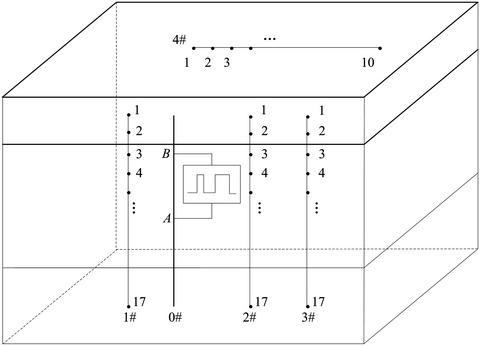当前位置:
X-MOL 学术
›
Energy Sci. Eng.
›
论文详情
Our official English website, www.x-mol.net, welcomes your
feedback! (Note: you will need to create a separate account there.)
Research on cross‐well pseudorandom electromagnetic detection method and extraction of response characteristics
Energy Science & Engineering ( IF 3.5 ) Pub Date : 2020-06-27 , DOI: 10.1002/ese3.767 Xijin Song 1 , Moe Momayez 2 , Xuelong Wang 1 , Tao Chen 3 , Feng Dang 3
Energy Science & Engineering ( IF 3.5 ) Pub Date : 2020-06-27 , DOI: 10.1002/ese3.767 Xijin Song 1 , Moe Momayez 2 , Xuelong Wang 1 , Tao Chen 3 , Feng Dang 3
Affiliation

|
A method is proposed that uses the metal casing of an oil and gas production well to construct a long dipole emission line source and applies pseudorandom multifrequency excitation signals to it to identify reservoir characteristics of interwell reservoirs. This method can significantly improve the work efficiency and precision of electrical prospecting. The cross‐well pseudorandom response signal contains multiple main frequency components, as well as various measuring frequency points. Targeting the frequency components with different amplitudes and initial phases in the pseudorandom signal, the digital coherent detection method and its noise resistance are studied. Using this method can effectively extract the amplitude and phase information of each frequency component in different noise environments and has a strong ability to suppress signals of other frequencies. In the heterogeneous interwell reservoir detection model, the amplitude characteristics of each frequency component of the pseudorandom electromagnetic response at the measuring line with different well spacings are extracted. Numerical results show that the curve of equal‐frequency measurement appears downwardly "concave" at the interface of the low‐resistivity interlayer, and upwardly "convex" at the interface of the high‐resistivity interlayer. With the increase in the resistivity of the low‐resistivity interlayer, the dynamic range of the extraction component of the same frequency decreases gradually, and the family of equal‐frequency response curves overlap with each other. By contrast, for the high‐resistivity interlayer, as its resistivity gradually increases, the dynamic range of the extraction component of same frequency also increases gradually. Moreover, as well spacing varies, the response characteristics of the equal‐frequency curve family on different measuring lines are also obviously different. The digital coherent detection method significantly simplifies the receiving circuit system. In practical application, response information of different discrete frequency components can be extracted according to requirements. This thus provides a theoretical basis for the extraction of resistivity and characteristic identification of interwell heterogeneous oil and gas reservoirs.
中文翻译:

井间伪随机电磁检测方法及响应特征提取研究
提出了一种利用油气生产井的金属套管构造长偶极子发射线源并对其施加伪随机多频激励信号来识别井间油藏特征的方法。该方法可以大大提高电勘探的工作效率和精度。井间伪随机响应信号包含多个主频率分量以及各种测量频率点。针对伪随机信号中具有不同幅度和初始相位的频率分量,研究了数字相干检测方法及其抗噪声性能。使用此方法可以有效地提取不同噪声环境中每个频率分量的幅度和相位信息,并且具有强大的抑制其他频率信号的能力。在非均质井间储层检测模型中,提取了不同井距的测量线上伪随机电磁响应各频率分量的幅度特征。数值结果表明,等频率测量曲线在低电阻率夹层的界面向下“凹”,在高电阻率夹层的界面向上“凸”。随着低电阻率夹层电阻率的增加,相同频率的提取分量的动态范围逐渐减小,等频响应曲线族相互重叠。相比之下,对于高电阻率夹层,随着其电阻率逐渐增加,相同频率的提取分量的动态范围也逐渐增加。而且,随着间距的变化,等频率曲线族在不同测量线上的响应特性也明显不同。数字相干检测方法大大简化了接收电路系统。在实际应用中,可以根据需要提取不同离散频率分量的响应信息。因此,这为井间非均质油气藏的电阻率提取和特征识别提供了理论基础。相比之下,对于高电阻率夹层,随着其电阻率逐渐增加,相同频率的提取分量的动态范围也逐渐增加。而且,随着间距的变化,等频率曲线族在不同测量线上的响应特性也明显不同。数字相干检测方法大大简化了接收电路系统。在实际应用中,可以根据需要提取不同离散频率分量的响应信息。因此,这为井间非均质油气藏的电阻率提取和特征识别提供了理论基础。相比之下,对于高电阻率夹层,随着其电阻率逐渐增加,相同频率的提取分量的动态范围也逐渐增加。而且,随着间距的变化,等频率曲线族在不同测量线上的响应特性也明显不同。数字相干检测方法大大简化了接收电路系统。在实际应用中,可以根据需要提取不同离散频率分量的响应信息。因此,这为井间非均质油气藏的电阻率提取和特征识别提供了理论基础。同样频率的提取分量的动态范围也逐渐增大。而且,随着间距的变化,等频率曲线族在不同测量线上的响应特性也明显不同。数字相干检测方法大大简化了接收电路系统。在实际应用中,可以根据需要提取不同离散频率分量的响应信息。因此,这为井间非均质油气藏的电阻率提取和特征识别提供了理论基础。同样频率的提取分量的动态范围也逐渐增大。而且,随着间距的变化,等频率曲线族在不同测量线上的响应特性也明显不同。数字相干检测方法大大简化了接收电路系统。在实际应用中,可以根据需要提取不同离散频率分量的响应信息。因此,这为井间非均质油气藏的电阻率提取和特征识别提供了理论基础。数字相干检测方法大大简化了接收电路系统。在实际应用中,可以根据需要提取不同离散频率分量的响应信息。因此,这为井间非均质油气藏的电阻率提取和特征识别提供了理论基础。数字相干检测方法大大简化了接收电路系统。在实际应用中,可以根据需要提取不同离散频率分量的响应信息。因此,这为井间非均质油气藏的电阻率提取和特征识别提供了理论基础。
更新日期:2020-06-27
中文翻译:

井间伪随机电磁检测方法及响应特征提取研究
提出了一种利用油气生产井的金属套管构造长偶极子发射线源并对其施加伪随机多频激励信号来识别井间油藏特征的方法。该方法可以大大提高电勘探的工作效率和精度。井间伪随机响应信号包含多个主频率分量以及各种测量频率点。针对伪随机信号中具有不同幅度和初始相位的频率分量,研究了数字相干检测方法及其抗噪声性能。使用此方法可以有效地提取不同噪声环境中每个频率分量的幅度和相位信息,并且具有强大的抑制其他频率信号的能力。在非均质井间储层检测模型中,提取了不同井距的测量线上伪随机电磁响应各频率分量的幅度特征。数值结果表明,等频率测量曲线在低电阻率夹层的界面向下“凹”,在高电阻率夹层的界面向上“凸”。随着低电阻率夹层电阻率的增加,相同频率的提取分量的动态范围逐渐减小,等频响应曲线族相互重叠。相比之下,对于高电阻率夹层,随着其电阻率逐渐增加,相同频率的提取分量的动态范围也逐渐增加。而且,随着间距的变化,等频率曲线族在不同测量线上的响应特性也明显不同。数字相干检测方法大大简化了接收电路系统。在实际应用中,可以根据需要提取不同离散频率分量的响应信息。因此,这为井间非均质油气藏的电阻率提取和特征识别提供了理论基础。相比之下,对于高电阻率夹层,随着其电阻率逐渐增加,相同频率的提取分量的动态范围也逐渐增加。而且,随着间距的变化,等频率曲线族在不同测量线上的响应特性也明显不同。数字相干检测方法大大简化了接收电路系统。在实际应用中,可以根据需要提取不同离散频率分量的响应信息。因此,这为井间非均质油气藏的电阻率提取和特征识别提供了理论基础。相比之下,对于高电阻率夹层,随着其电阻率逐渐增加,相同频率的提取分量的动态范围也逐渐增加。而且,随着间距的变化,等频率曲线族在不同测量线上的响应特性也明显不同。数字相干检测方法大大简化了接收电路系统。在实际应用中,可以根据需要提取不同离散频率分量的响应信息。因此,这为井间非均质油气藏的电阻率提取和特征识别提供了理论基础。同样频率的提取分量的动态范围也逐渐增大。而且,随着间距的变化,等频率曲线族在不同测量线上的响应特性也明显不同。数字相干检测方法大大简化了接收电路系统。在实际应用中,可以根据需要提取不同离散频率分量的响应信息。因此,这为井间非均质油气藏的电阻率提取和特征识别提供了理论基础。同样频率的提取分量的动态范围也逐渐增大。而且,随着间距的变化,等频率曲线族在不同测量线上的响应特性也明显不同。数字相干检测方法大大简化了接收电路系统。在实际应用中,可以根据需要提取不同离散频率分量的响应信息。因此,这为井间非均质油气藏的电阻率提取和特征识别提供了理论基础。数字相干检测方法大大简化了接收电路系统。在实际应用中,可以根据需要提取不同离散频率分量的响应信息。因此,这为井间非均质油气藏的电阻率提取和特征识别提供了理论基础。数字相干检测方法大大简化了接收电路系统。在实际应用中,可以根据需要提取不同离散频率分量的响应信息。因此,这为井间非均质油气藏的电阻率提取和特征识别提供了理论基础。











































 京公网安备 11010802027423号
京公网安备 11010802027423号